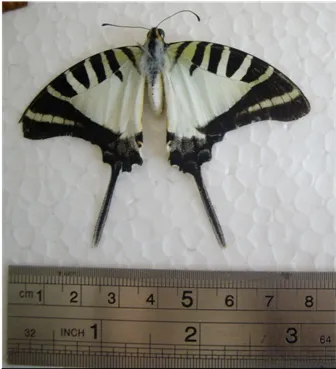The Euphrates River is in the Middle East. Graphium euphrates is found in the Philippine Islands and Sulawesi. Early naturalists named the Swallowtails after heroes of literature. Rivers were in fact personified as characters in some ancient literature; they were believed to have spirits that could talk if you could only understand their language, and could give or withhold favors for which people asked. However, if the Euphrates was cast as a hero, the story has been forgotten.
Photo by Chrischafer. The butterfly is a pretty little thing, very similar to some other Graphiums; not all lists include it as a separate species. It can survive a reasonable amount of at least suburbanization. It does not seem to be endangered, or even threatened.
In some lights the pale color on the wings can iridesce light blue.
In other lights it can look chalky white.
There are a lot of Graphium species, and from time to time people try to divide this genus into subgenera so that the species can be listed with different genus names. There is some disagreement about whether to call euphrates and its look-alikes Arisbe or Pathysa.
Sorting out the look-alike species can be a challenge for experts. Per Adam Cotton:
"
One good way to distinguish decolor from euphrates is to look at the bands of the forewing cell. In decolor the 4th band from the base is normally narrower than the second and third bands, whereas in euphrates it is as broad or broader. Also on the underside the outer discal parallel black mark in space 7 is straight in euphrates but slightly bent in decolor.
"
Euphrates has been listed as a subspecies of antiphates and as a synonym of moorei. Decolor and euphratoides have been listed as subspecies of both antiphates and euphrates. Real science does not reach a "settled" state readily and seldom stays in one for long.
Some lists include subspecies of euphrates. In addition to decolor and euphratoides, which are more often considered as separate species, subspecies of euphrates have included boholensis, buhisanus, cuyoensis, domaranus, elegantia, nisus, ornatus, and zebraica. Legantia, sometimes included as a subspecies name, is probably a misprint for elegantia. The first four subspecies names refer to places; the meanings of the last four are obvious. (Probably. Nisus was a character in Greek mythology.)
However, no online source except Funet bothers about subspecies. Separating the look-alike species appears to give naturalists enough of a challenge. Then again, Google's commitment to "force traffic" to paying commercial sites by cutting off searches may be suppressing more detailed academic material from search results. What Google displays on a search for "graphium euphrates" is debased enough, with links to, among other things, a tabletop ornament described as a "zombie house" with these butterflies, and other things, as decoration--though euphrates is not one of the species with eerily gleaming reflective white patches on the wings.
Butterflies' wings are usually transparent and colorless beneath the layers of scales on the surface, but in this species group parts of the wings have a light yellow-green color that shows and iridesces through the pale surface. A microscopic examination is said to show that some of the scales toward the front edge of the fore wings are shaped like hairs, shorter and finer than the furry hairs on the inside edges of the male hind wings.
Host plants are Annonaceae in the genera Annona, Desmos, and Uvaria. Again, as the taxonomy of this species group remains in an unsettled state, nobody seems to want to say much about the earlier stages--though rearing these butterflies and seeing what they ate, and how they reacted to one another, would be one way to settle the question of which ones may be considered subspecies of which other ones.



No comments:
Post a Comment